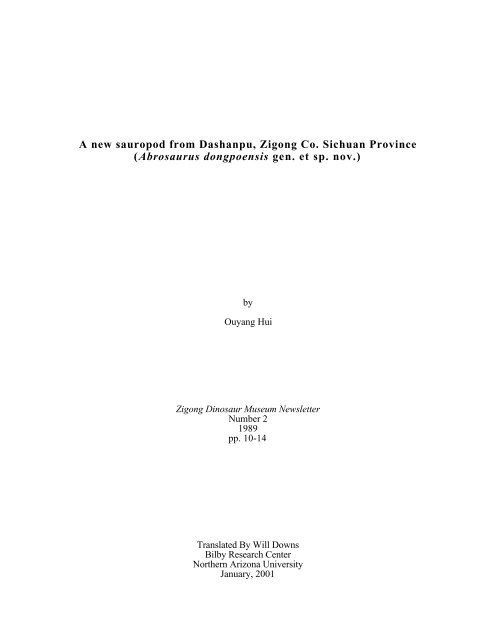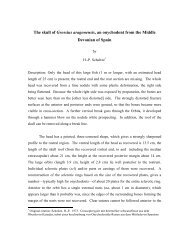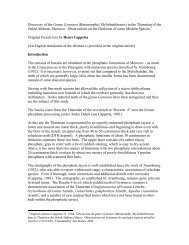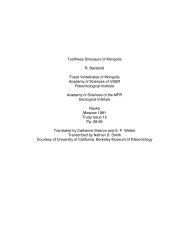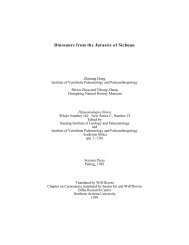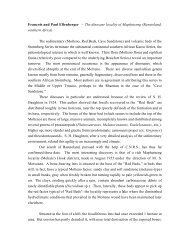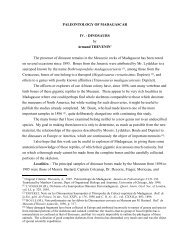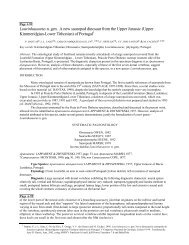A new sauropod from Dashanpu, Zigong Co. Sichuan Province ...
A new sauropod from Dashanpu, Zigong Co. Sichuan Province ...
A new sauropod from Dashanpu, Zigong Co. Sichuan Province ...
You also want an ePaper? Increase the reach of your titles
YUMPU automatically turns print PDFs into web optimized ePapers that Google loves.
A <strong>new</strong> <strong>sauropod</strong> <strong>from</strong> <strong>Dashanpu</strong>, <strong>Zigong</strong> <strong>Co</strong>. <strong>Sichuan</strong> <strong>Province</strong><br />
(Abrosaurus dongpoensis gen. et sp. nov.)<br />
by<br />
Ouyang Hui<br />
<strong>Zigong</strong> Dinosaur Museum Newsletter<br />
Number 2<br />
1989<br />
pp. 10-14<br />
Translated By Will Downs<br />
Bilby Research Center<br />
Northern Arizona University<br />
January, 2001
Introduction<br />
To date, there were three genera and species of Middle Jurassic <strong>sauropod</strong>s documented<br />
<strong>from</strong> the locality of <strong>Dashanpu</strong>, <strong>Zigong</strong> <strong>Co</strong>., <strong>Sichuan</strong> <strong>Province</strong>: Shunosaurus lii, Datousaurus<br />
bashanensis, and Omeisaurus tianfuensis. In 1984 an exceptionally complete <strong>sauropod</strong> skull was<br />
collected <strong>from</strong> the central excavation chamber of the <strong>Zigong</strong> Dinosaur Museum that was quite<br />
distinct <strong>from</strong> the aforementioned taxa. This text provides a brief description of the specimen and<br />
erects a <strong>new</strong> genus and species. Postcranial specimens have still not been excavated and will be<br />
described in a future publication with a more detailed description of the skull.<br />
Sauropoda Marsh, 1878<br />
Camarasauridae <strong>Co</strong>pe, 1877<br />
Diagnosis: As for species.<br />
Specimen description<br />
Cetiosaurinae Jenensch, 1929<br />
Abrosaurus Gen. Nov.<br />
Abrosaurus dongpoensis gen. et sp. nov.<br />
Etymology: The prefix “Abr” indicating delicate or graceful, which is basically the main<br />
character of the skull. Species nomenclature Dongpo is the stylized name of the distinguished<br />
Northern Sung Dynasty literary scholar <strong>from</strong> <strong>Sichuan</strong> named Sushi (1037-1101).<br />
Diagnosis: A moderate sized <strong>sauropod</strong> with a delicately constructed skull and extremely<br />
large lateral cranial fenestrae. Height/length index is 1:1.8, ventral region is elongated, nasal crest<br />
is high, quadrate is nearly perpendicular, dorsal premaxillary process and the dorsal branch of the<br />
maxilla are equivalently long and are exceptionally slender and elongated. External nares are larger<br />
than the orbits, and antorbital fenestra is triangular. Parietal is narrow and the two supratemporal<br />
fenestra are in relatively close proximity. The mandible is thin with the midportion of the dentary<br />
being dorsoventrally constricted. Dentition with numerous basically spoon-shaped teeth, a lingual<br />
medial crest on the teeth is not well developed, labial striations are dense but pinnate striations are<br />
absent. Premaxillary teeth lack serrations, maxillary teeth possess only a few serrations, and<br />
mandibular replacement teeth possess a small amount of anterior and posterior serrations in<br />
addition to an extremely weak medial crest.<br />
Type specimen: An exceptionally complete skull. <strong>Zigong</strong> Dinosaur Museum specimen #<br />
ZDM5038.<br />
Hypodigm: A fragmentary skull preserving only the post orbital region. <strong>Zigong</strong> Dinosaur<br />
Museum specimen # ZDM5033.<br />
Locality and stratigraphic position: Lower Jurassic Xiaximiao Fm., <strong>Dashanpu</strong>,<br />
<strong>Zigong</strong> <strong>Co</strong>., <strong>Sichuan</strong> <strong>Province</strong>.<br />
Description: The type specimen is exceptionally well preserved and has been exquisitely<br />
prepared, clearly defining the cranial outline, external and internal cranial elements, and fenestra<br />
(including the cranial nerve complex). The skull has been subjected to a very slight degree of<br />
lateral compressional distortion, the left lacrimal is not preserved, the left jugal and quadrate have
2<br />
been partially displaced, and only the posterior half of the left mandible is preserved. Among all<br />
the cranial elements, only the vomer is absent and the right lateral side of the skull is not completely<br />
exposed (see plates I-III).<br />
In lateral perspective the skull is a right angle trapezoid with the right angle represented by<br />
the intersection of the occiput and the parietal, the latter of which is parallel to the dentition. Skull<br />
height/length index (including mandible) is 1:1.8, indicating a longer and lower skull than other<br />
camarasaurids (Table I). In both dorsal and ventral perspective the skull is wedge shaped, and<br />
relatively laterally compressed. The highest point on the skull is at the posterior margin of the<br />
orbit, and the rostrum is slightly acute. In posterior perspective the skull is square with the<br />
occipital located in the midsection.<br />
The description of cranial elements is given for the type specimen. The inter-occipital<br />
suture line is vague, the trough on the ventral surface of the basioccipital is shallow, the<br />
basioccipital processes are not well developed, and the occipital condyle is relatively small. The<br />
exoccipitals form the dorsal and lateral walls of the foramen magnum and the paroccipital processes<br />
are moderately developed. The supraoccipital is small, at its midsection it is rounded, and the<br />
occipital crest is low and gently rounded.<br />
The morphology of the parietal resembles the pro<strong>sauropod</strong> condition, with an extremely<br />
narrow and flat midsection and an anterior and posterior vertical process. The posterior process is<br />
relatively well developed, constituting the dorsal occipital surface. The parietal-occipital suture<br />
resembles the unossified crevice on the pro<strong>sauropod</strong>s.<br />
The prefrontal is relatively long with a beak-shaped process that overlies the lacrimal.<br />
Nasals are narrow and elongated, constituting approximately one-third the length of the skull.<br />
They each have a short lateral process that contacts the maxilla and an extremely well developed<br />
anterior process that contacts the premaxilla. The anteriorly oblique lacrimal is extremely thin,<br />
elongated, and constricted at its midsection.<br />
Table 1. Cranial measurements for Abrosaurus dongpoensis<br />
gen. et sp. nov. (ZDM5038) (cm).<br />
Maximum length 45.6<br />
Breadth between lateral frontal processes 17.2<br />
Breadth between jugals 13.0<br />
Breadth between first maxillary teeth 7.2<br />
Maximum height (including mandible with restored articular) 25.2<br />
Height <strong>from</strong> parietal to quadrate terminus 18.0<br />
Height <strong>from</strong> skull roof to ventral occipital condyle 12.2<br />
Maximum length of mandible 41.6<br />
Anterior height of mandible 7.8<br />
Mandibular fenestra to anterior end 27.4<br />
Mandibular fenestra diameter (L/H) 2.3/1.0<br />
Adductor fossa length 11.0<br />
Adductor fossa height 3.5<br />
The quadrate is nearly perpendicular with a large portion of its dorsolateral surface<br />
obscured by the squamosal, its ventrolateral surface is obscured by the quadratojugal, and there is<br />
only a hooked-shaped portion of it visible posteriorly. The articular condyle is not very robust.<br />
The stapes is a small slender claviform element, one end of which penetrates the stapedial<br />
canal and the other which is in contact with the quadrate.
The quadratojugal is a thin, narrow, and L-shaped element with its horizontal arm longer<br />
than its vertical arm. The jugal is relatively small with a weak dorsal process in contact with the<br />
lacrimal, it has a relatively well developed posterior process in contact with the postorbital, and a<br />
relatively well developed ventral process in contact with the quadratojugal.<br />
The maxillary ramus is low and long, the dental margin is long, and on the medial side<br />
there is a distinct shallow row of replacement alveoli. The dorsal process is thin, long and ascends<br />
posteriorly <strong>from</strong> the midsection of the ramus at a 40° angle, dividing the nasal and prefrontal and<br />
terminating in a contact with anterior margin of the lacrimal. The dorsal process of the premaxilla<br />
is thin and long, ascends to the midpoint, or highest point of the external nares, to form an arched<br />
crest with the nasals. The midline between the premaxillae is sutured to form an acute rostrum.<br />
The pterygoids are the largest pair of elements on the palate, extending <strong>from</strong> the posterior<br />
end of the cranium to the anterior end of the maxilla. The ventral quadrate process thickens to<br />
compose an acute laminar projection which reaches the posterior margin of the quadrate. Its dorsal<br />
margin is a thin, concave, spoon-shaped element that fuses with the medial side of the quadrate’s<br />
pterygoid process. The angle between the anterior and transverse pterygoid processes is<br />
approximately 70°. The anterior process is long, thin, and acute. The roofs of both anterior<br />
processes are sutured within the interpterygoid vacuity. The ectopterygoids are small, thin, fanshaped<br />
elements that are posteriorly broadened and anteriorly claviform. They contact the medial<br />
jugal and maxilla and are overlain by the transverse processes of the pterygoids.<br />
The palatine is a single claviform projection that contacts the palatal process of the maxilla.<br />
Posteriorly it is fan-shaped and fused to the ventral ectopterygoid, its thin anterior process<br />
traverses the anterolateral pterygoid process and would ultimately contact the vomer, which is<br />
missing. These three elements compose an extremely narrow bar that divides the extremely large<br />
internal nares.<br />
The postorbital, squamosal, basipterygoid, laterosphenoid, and orbitosphenoid are<br />
typically saurischian in morphology. Worthy of note is that the lamina composed of the<br />
orbitosphenoid and alisphenoid, which constitutes the posterior wall of the orbit, is positioned<br />
rather posteriorly, thereupon compressing the braincase into a short but slightly deep cavity.<br />
Lateral cranial fenestrae are all extremely large, representing one of the principle characters<br />
for the genus. The subtemporal fenestra is nearly an equilateral triangle in shape and equivalent in<br />
size to the orbit. The orbit is oval with its long axis anteriorly oblique. It is positioned rather<br />
posteriorly (midpoint is 34.0 cm <strong>from</strong> rostrum) and thus the facial region is spacious whereas the<br />
postorbital region is compressed. The elliptical external nares are the largest fenestrae on the skull,<br />
are 1.5 times the size of the orbit, and are divided only by an extremely thin medial nasal crest.<br />
The isosceles-triangle-shaped antorbital fenestra is extremely large, or one-half the size of the orbit,<br />
and is surrounded by the maxilla and lacrimal.<br />
The supratemporal fenestrae are in close proximity, and are shaped as laterally broadmedially<br />
narrow, opposing triangles. Their anterior margin is composed of the frontal and the<br />
anterior process of the parietal, but their posterior wall is composed entirely of the posterior<br />
parietal.<br />
On the type specimen the foramen magnum is rhomboid due to compressional distortion,<br />
but on the hypodigm it is nearly circular and moderate in size with a diameter of 24 mm.<br />
Smaller cranial foramina are visible on the type and particularly distinct on the hypodigm.<br />
These include foramina for the olfactory (I), optic (II), oculomotor (II), trigeminal (V),<br />
glossopharyngeal (IX), and hypoglossal (XII) nerves. Also visible are the oval foramen, the<br />
foramen for the internal carotid, and several foramina which have yet to be adequately identified.<br />
3
4<br />
Only the posterior half of the left mandible is preserved but the right mandible is completely<br />
preserved in articulation with the skull and, resembling the condition of the skull, is a relatively<br />
thin and gracile element. The anterior end is relatively deep but the deepest point on the mandible<br />
is at the coronoid process. Between these two points the dentary is distinctly dorsoventrally<br />
constricted. The ventral margin on the anterior half of the mandible is dorsally embayed, but on<br />
the posterior half, the mandible gradually descends ventrally. A small lateral mandibular fenestra is<br />
present. On the medial side there is a relatively large oval depression to facilitate adductor<br />
musculature. The coronoid process is relatively well developed although a retroarticular process is<br />
weak. The dentary is extremely elongated, constituting approximately two-thirds the length of the<br />
mandible and a Meckelian groove is conspicuous.<br />
Table 2. Mandibular measurements for Abrosaurus dongpoensis<br />
gen. et sp. nov. (ZDM5038) (cm).<br />
Mandible length 41.6<br />
Anterior height 7.8<br />
Distance <strong>from</strong> mandibular foramen to anterior end 27.4<br />
Mandibular foramen diameter (L/W) 2.3/1.0<br />
Length of adductor fossa 11.0<br />
Height of adductor fossa 3.5<br />
The relatively thin angular composes the posterior half of the mandible. The surangular is<br />
relatively large, overlies the dentary anterolaterally, and the articular posteriorly. The prearticular<br />
lies anterior to the articular and in medial view appears as a lineation between the angular and<br />
surangular that extends to the anterior margin of the mandibular foramen. The splenial is thin,<br />
smooth, and triangular. Its midsection obscures the medial dentary, angular, and prearticular. The<br />
articular fossa appears to be smaller than in any taxa taxon of <strong>sauropod</strong> known (see inside back<br />
cover plate).<br />
The dentition is basically spoon-shaped with a relatively shallow lingual surface. Teeth in<br />
both upper and lower dentitions are abundant, represented by the following formula: PM: 5,<br />
M: 15-17, D: 16-18. The premaxillary count of 5 is not documented on any other <strong>sauropod</strong>.<br />
Tooth crowns are relatively long and acute with their broadest point approaching the base of the<br />
crown, a medial lingual ridge is absent as are pinnate striations, but longitudinal striations are<br />
densely packed, and serrations on both anterior and posterior margins are absent. Ten teeth are<br />
preserved on the left maxilla but on the right there are only four functional and two replacement<br />
teeth, There is distinct morphological variation between anterior and posterior teeth with the<br />
anterior being relatively large, symmetrical, and elliptical. Teeth in the mid-series are narrow, high<br />
crowned, and posteriorly oblique. The posterior series is small, crowns again resume being<br />
symmetrical, but are low and blunt. A few serrations are present only on the anterior margin,<br />
lingual longitudinal striations are well developed, but pinnate striations are absent. All the teeth on<br />
the mandible have dropped out and become lost with the exception of three replacement teeth which<br />
display an extremely weak lingual medial ridge and a small number of serrations anteriorly and<br />
posteriorly.<br />
<strong>Co</strong>mparison and discussion:<br />
As mentioned above, there were three genera and three species of <strong>sauropod</strong>s represented at<br />
the <strong>Dashanpu</strong> locality of <strong>Zigong</strong> <strong>Co</strong>. Abrosaurus was excavated <strong>from</strong> the same locality as the other<br />
taxa.<br />
Shunosaurus lii is also represented by exceptionally complete cranial material and shares<br />
characters including an abundant basically spoon-shaped dentition and a vertical quadrate. But
Abrosaurus differs in its relatively low and elongated skull, being more gracile in construction,<br />
lateral cranial fenestrae are larger, antorbital fenestra is extremely distinct in size and morphology,<br />
maxillary and mandibular morphology are extremely distinct, and dental characters are not<br />
completely consistent. Shunosaurus cranial height/length index is 1:1.6, maxillary ramus is<br />
relatively high, coronoid process is short, ventral margin of the mandible does not descend,<br />
anterior end is very low, lateral mandibular foramen is relatively large, and teeth are all relatively<br />
long and acute with well developed lingual pinnate striations. These distinctions exceed the<br />
parameters for individual or intraspecific variation.<br />
Table 3. Dental measurements for Abrosaurus dongpoensis<br />
gen. et sp. nov. (ZDM5038) mm.<br />
Crown Crown Height/<br />
Sequence Height Breadth breadth index<br />
Left Pm1 32 17 1.89<br />
Pm2 30 16 1.88<br />
Pm3 25+ 15 1.67+<br />
Pm4 30 15 2<br />
Pm5 32 16 2<br />
Right Pm1 28+ 17 1.65+<br />
Pm2 30 15 2<br />
Pm3 30+ 15 2+<br />
Pm4 30+ 15 2+<br />
Pm5 27+ 15 1.8+<br />
Left M1 25+ 17 1.47+<br />
M8 30 13 2.31<br />
M9 23 11 2.09<br />
M10 16 10 1.6<br />
M11 15 9 1.67<br />
M12 14 9 1.56<br />
M13 12 9 1.33<br />
M14 10 7 1.43<br />
Right M1 32+ 20 1.6+<br />
M10 25 10 2.5<br />
D11 20+ 12 Replacement<br />
D14 16+ 10 Replacement<br />
Omeisaurus tianfuensis lacks a complete skull but is still represented by relatively abundant<br />
cranial material. It shares characters with Abrosaurus in the morphology of the maxilla, jugal,<br />
postorbital, and anterior mandible. However, there are numerous distinctions, including the large<br />
and robust nature of the skull which is in direct contrast to the gracile construction of Abrosaurus.<br />
There are also either large or small discrepancies between the two skulls in cranial outline, location<br />
and size of fenestrae, and mandibular and dental morphology. In lateral perspective the<br />
Omeisaurus skull is wedge-shaped with a relatively low nasal crest. Furthermore, its quadrate is<br />
anteriorly oblique, the lateral cranial fenestrae are smaller, the mandible is thick and robust with an<br />
extremely high anterior end, dentition is much more reduced, teeth are robust and typically spoonshaped<br />
with numerous anterior serrations, and there are extremely well developed lingual and<br />
pinnate striations. Another <strong>sauropod</strong> genus <strong>from</strong> the <strong>Dashanpu</strong> quarry, Bashunosaurus, is<br />
represented by a damaged skull. However, after restoration, it appears to be generally consistent<br />
with Omeisaurus although its maxillary morphology is more consistent with Shunosaurus, it lacks<br />
5
6<br />
a mandibular fenestra and has an even more reduced dentition, distinguishing it further <strong>from</strong><br />
Abrosaurus.<br />
Prior to the discovery of the <strong>Dashanpu</strong> quarry, cranial data for Chinese <strong>sauropod</strong>s was<br />
deficient, being represented only by fragmentary remains of Euhelopus zdanskyi and<br />
<strong>Zigong</strong>osaurus fuxiensis, both of which represent stratigraphic intervals higher than Abrosaurus<br />
and are extremely distinct in morphology, representing more phylogenetically distant genera.<br />
Among the taxa outside of China, Camarasaurus displays lateral cranial fenestrae that are all<br />
extremely large and basically consistent in morphology with Abrosaurus in addition to many<br />
cranial elements that are also consistent. However, the height and robustness of the Camarasaurus<br />
skull is distinct, its mandible is thick and lacks and a fenestra, dentition is extremely reduced, the<br />
parietal is relatively broad, the lateral quadrate is completely obscured by the quadratojugal, and the<br />
lateral cranial fenestrae are not as expanded as on Abrosaurus. Furthermore, as it is produced <strong>from</strong><br />
the Upper Jurassic Morrison Fm. of North America, it is extremely distinct geochronologically.<br />
Thus, Abrosaurus displays a plethora of characters that justifies its erection as a <strong>new</strong> genus<br />
and species.<br />
Steel (1970) subdivides the suborder Sauropoda into the two families Camarasauridae<br />
<strong>Co</strong>pe 1877 and Atlantosauridae Marsh 1877. Abrosaurus is assigned to the former family.<br />
Abrosaurus shares several characters with the Pro<strong>sauropod</strong>a including extremely large<br />
cranial fenestrae, cranial morphology being slightly low and elongated, high dental count, retention<br />
of a mandibular fenestra, and similar morphology and contact relationships of the parietal,<br />
quadratojugal, squamosal, and quadrate. Furthermore, as its age represents the early evolution of<br />
the <strong>sauropod</strong>s, or the early Middle Jurassic, Abrosaurus is more appropriately provisionally<br />
assigned to the subfamily Cetiosaurinae. However, it is worth noting that this subfamily contains<br />
nearly all the taxa of Early to Middle Jurassic <strong>sauropod</strong>s, and thus is obviously not a natural<br />
taxonomic rank. With the increase of fossil data, and particularly with the erection of more genera<br />
with skulls <strong>from</strong> the <strong>Dashanpu</strong> quarry, it will be necessary to elevate this subfamily to family status<br />
and the subsequently erected <strong>new</strong> subfamilies and the Cetiosauridae will have to be further revised<br />
and defined, and adjustments will have to be made to its phylogenetic status. Obviously, the scope<br />
of that work is outside the limitations of this short report. The author of this paper aspires to<br />
conclude research on the postcranial skeleton of Abrosaurus, will then conduct further discussions<br />
upon this subject, and further elaborate upon the evolutionary significance of Abrosaurus<br />
dongpoensis.<br />
Acknowledgments<br />
The author would like to express his appreciation to Professor Xinlu He of the Chengdu<br />
Academy of Geology for his conscientious guidance; to colleagues Zheng Jiao, Shida Zhu, Renyan<br />
Gao, and Xiaozhong Pi for their attention and support; and to professors Kaiji Cai and Kui Li of<br />
the Chengdu Academy of Geology for their great assistance.<br />
Bibliography<br />
Steele. R., 1970; Saurischia. Hdb. Paläoherpetol. 15, 1-87.


